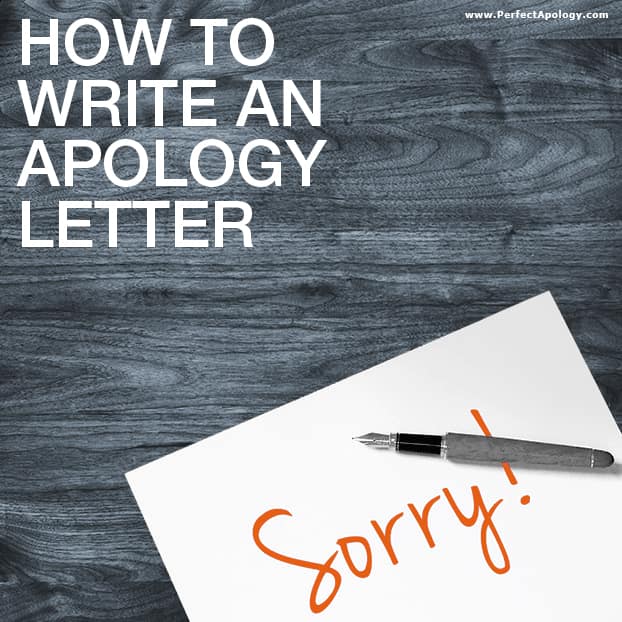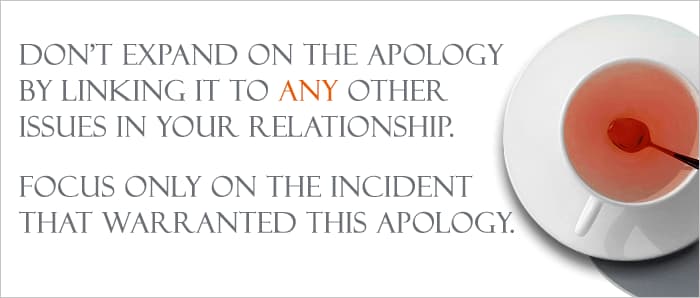How To Write An Apology Letter: Step-by-Step Guide
Writing an apology letter is a powerful way to express remorse, repair relationships, and rebuild trust. A well-crafted apology includes four essential elements:
1. A clear statement of apology —Begin with a sincere "I'm sorry" or "I apologize."
2. Acknowledgement of the mistake — Show understanding of the impact your actions had.
3. Expression of regret — Convey genuine remorse and empathy.
4. Commitment to change — Offer a resolution and a promise to improve.
Follow this guide to craft a heartfelt apology letter with proven templates outlining the four essential elements of a sincere and effective apology letter, examples, sample openings and closings, Dos and Don'ts, and frequently asked questions.

How to Write an Apology Letter: Anatomy & Key Components
→ THE CONTENT: WHAT TO SAY
Crafting a sincere apology involves primarily knowing the right words. Our letter template, complete with sample blurbs, guides you in constructing a well-phrased apology.
→ FORMAT, STYLE & DELIVERY: HOW TO SAY IT
The way you deliver your apology matters. Formal typed letters work well in professional settings or when you want to show respect, while handwritten letters and notes add a personal touch.
Learn more about apology letter formats or if time is of the essence check out our Apology Letter Toolkit ⇗ for easy to copy & paste sample apologies.
How to Write an Apology Letter: 4 Essential Elements (Template & Examples)
1. Apologize and Provide a Detailed Account
Begin your letter by acknowledging the wrongdoing, apologizing, and offering a detailed account of the incident. It's important that the recipient knows that you clearly understand what happened and where you went wrong.
For instance,
Dear______________,
I'd like to apologize for my words and actions on Wednesday at the club. I should have been more supportive of both you and your ideas when you presented them.
As the newest member of our group, I noticed your uncertainty and unfortunately used it to undermine your confidence. You were clearly well-prepared, yet I dismissed your ideas prematurely without allowing you to fully explain them.
2. Acknowledge the Hurt and Take Responsibility
The main body of your letter should focus on acknowledging the pain caused and taking full responsibility. Convey empathy to show the recipient that you understand their perspective and accept accountability for your words and actions.
Here’s how you might express it:
I could see the hurt in your eyes, and yet I persisted in my criticism. I unfairly cast you in a negative light in front of our friends and other members, which was entirely unwarranted. My intention was never to embarrass and hurt you or make everyone uncomfortable.
I sincerely apologize—it was never my intention.
The truth is, work stress and a bad mood got the best of me, and I unfairly directed it at you. There's no excuse for my behavior, and I truly regret it.
3. Express Regret and Ask for Forgiveness
Genuine regret is essential. Explicitly ask for forgiveness, empowering the recipient to decide the fate of the relationship.
For example:
I regret how I acted and every word I uttered. I feel terrible about bringing my work stress and family tension to the club that day and releasing it all on you. It had nothing to do with you, your ideas, or your ability.
Please forgive me.
4. Make a Promise for Change
Close the letter by assuring the recipient that such actions won’t happen again. Without promising and changing your future behavior, apologies lose their impact. Consider offering restitution (if possible) and inquire if there’s anything else you can do to make things right:
I respect you too much and cherish our friendship to let this happen again. Moving forward, if I ever feel that type of stress or find myself in a bad mood, I'll distance myself from those I care about until the feelings pass.
Meanwhile, I've spoken to everyone who attended last Wednesday about my behavior. I've also encouraged them to give you the floor next time we meet if you're up for it.
If there's anything else I can do, please let me know.
Over time, I hope you'll learn to trust me again, knowing that I'm always on your side.
Yours sincerely,

Summary: How To Write An Apology Letter
1. Start with An Apology & Your Heartfelt RegretBegin your letter with a genuine apology and expression of regret. Clearly state what you’re apologizing for to show you understand the situation.
2. Acknowledge and Empathize
In the heart of your letter, acknowledge the impact of your actions. Show empathy and express sincere regret or remorse for any pain caused. Ask for forgiveness.
3. Commit to Positive Change Conclude with a promise to make things right. Outline steps you’ll take to prevent future issues and emphasize the value you place on the relationship.
How To Write An Apology Letter: Sample Openings
A sincere and personalized opening sets the tone for the apology.
The hardest part of writing an apology letter is often just getting started so we've included a few more examples of openings from some of the best apology letters submitted by our website visitors.
Hopefully these openings provide a starting point and demonstrate the diversity of sincere expression.
I'm truly sorry for mistrusting you. I don't know how to express my sincere apologies for the pain caused and the tears shed because of me.
To the love of my life... Please accept this heartfelt apology. If I had the ability to turn back time and take back everything that happened I would do it in a flash and never think that what we have, and had, could never be taken away by my selfish acts or my demeanor.
I know no amount words could express how truly sorry I am and how much regret I feel. I do not know how I could have been so foolish and for so long. I was blind and let my ego and pride get the best of me.
I'm truly sorry. I know you probably hate me right now and I don't blame you. I still have not forgiven myself and I don't think I ever will for acting how I did the last time we spoke.
Dear Kim...I've been really worried about writing. I know you’ve asked me not to. I will always respect your wishes. But for my sanity please let me apologize without my emotions doing all the talking this time.
Get more detailed information on the content of an apology letter on our page how to apologize.
How to Write an Apology Letter: Sample Closings
Reiterate the desire to make amends and reassure the recipient. Use closing statements that reinforce your commitment to change and signal a genuine effort to mend the relationship.
Let them know that you're trying to fix things and that you're open to any ideas they may have on how to remedy the situation.
Below are examples and suggestions for what to include before the final closing (e.g. Sincerely, Respectfully, etc.)
Please know that I have done everything I can think of to make sure this never happens again. I deeply regret it happened at all. You are very important to me and I am willing to do whatever it takes to correct things. If there is anything I can do to regain your trust, please let me know. I am truly sorry and humbly ask for your forgiveness...
I promise you that it won't happen again. It's important to me that I regain your trust and we're able to rely on each other in the future as we always have in the past. If there is anything else that I can do, just let me know...
I'm embarrassed by both my actions and words. I can't take back those words or pretend the whole incident never happened. It happened. So, if there is anything I can do to make you feel better, please let me know. I cherish our relationship and friendship more than you can imagine and am devastated at the thought of losing either. I promise you that I will never act or speak in that way ever again, you are too important to me...
Standard letter closings like 'Yours Truly' can be easily applied to apology letters. However, we like 'Sincerely' or 'Yours Sincerely' when it comes to apologies in general because they help reinforce the message.
'Respectfully' and 'Yours Respectfully' are particularly good for when we've been disrespectful or apologizing to an authority figure be it parent, teacher, boss etc.
Dos & Don'ts: How to Write An Apology Letter
Follow the tips below to ensure your apology is genuine and well-received.
✔ Do... Write clearly and accurately. Be honest and show true sincerity.
✔ Do... Let them know that you understand why they are hurt and angry.
✔ Do... Make sure your apology letter describes why and how much the person was injured by your actions. Saying 'I know you were hurt' is not the same as saying 'I know how insulted and angry you were because of...'.
✔ Do... Request forgiveness but don't expect or demand it.
✔ Do... Let them know that you appreciate the role they play in your life and why the apology is so important—whether or not they accept it.
X Don't... Use qualifiers like 'if' or 'but' anywhere in your apology. 'I'm sorry if I hurt you' and 'I apologize but I was in a bad mood that day' sounds like you're making excuses or trying to justify things.
X Don't... Try to evoke sympathy as part of your apology.
X Don't... Share blame, you need to take full responsibility.

Learn More From These Sample Apology Letters
DUI Apology Letter
Apologizing to a judge or employer is often a part of being charged.
Apology Letter to a Teacher
Learn how to write an apology letter to a teacher or professor.
Letter of Apology for Delay
Delays are inevitable and often have implications that need to considered.
Apology Letter to a Patient
Because common mistakes are made even within the healthcare industry.
Apology Letters: Format for Maximum Impact
Consider the format, tone, and delivery method to maximize the effectiveness when writing an apology letter.
Match your tone to the situation, choose words that feel genuine, consider the best way to deliver it—whether in writing or face-to-face, and then decide on the format of your letter which can be very important in making your apology effective. Send your apology promptly.
Keep the communication going after the apology, and make your letter visually appealing for a lasting impact. The true art of a sincere apology lies in blending heartfelt content with strategic formatting for a persuasive and genuine expression of remorse.
The Traditional Apology Letter In The Digital Age.
Apologies aren’t limited to pen and paper anymore—digital communication has changed how we express regret. If you're writing an apology email instead of a traditional letter, it's important to follow best practices to ensure your message is sincere and well-received.
Check out our guide on how to write an apology email for expert tips on tone, structure, and delivery. Learn how to craft a meaningful apology that resonates, whether you're sending it via email, text, or other digital platforms.
Apology Letter FAQ [Frequently Asked Questions]
Our apology letter FAQs are designed to help eliminate some of the barriers we all face when we sit down and write out an apology.
One of the primary obstacles is often a reluctance to admit that we're to blame for the situation. To state clearly and unequivocally that it was our fault.
And, by putting pen to paper and writing the words 'I was wrong. I'm sorry and I apologize', gives it a sense of permanence and causes us to feel vulnerable.
It's that vulnerability that is the most scary for many of us. So much is at stake when it comes to our relationships. Our minds begin to reel.
What are the benefits of writing an apology letter?
An apology letter gives you time to think about what you're writing and gives the recipient time to think about your apology before responding.
On the other hand, verbal apologies require you to think on your feet, be prepared for the recipient's reaction (negative or positive) and ready for the conversation that follows.
Does 'I apologize' & 'I'm sorry' mean the same thing?
Many people are surprised to hear that 'I apologize' and 'I'm sorry' don't mean the same thing and are not directly interchangeable. Writing 'I'm sorry' expresses a level of regret or remorse. It says to the recipient that you feel badly about what happened—that is has affected you emotionally.
'I apologize' is simply a statement of admission. You're admitting that you were at fault but you are NOT stating that you are sorry about it.
In most cases we recommend including both statements in an apology letter.
How do I write an apology letter?
Open your letter by apologizing. Say you're sorry and describe what happened. In the main body of the letter communicate your understanding of the hurt you caused and your regret. Ask for forgiveness, express a desire to fix the situation and promise that it won't happen. Finally, explain why the relationship is important to you.
Read our article on how to write an apology letter for more detailed instructions, a template letter, Dos & Don'ts, and more...
How do I format an apology letter?
There are many things to take into account when looking at how to format an apology letter. The predominant considerations are length and style.
In most cases, when all the elements of a sincere apology are included, the severity of the offence you're apologizing for will naturally determine its length.
In terms of style, handwritten apologies are best for personal and intimate relationships. Typewritten, emailed and more formal approaches are best suited for business and non-personal relationships (e.g. teacher, club member, shop owner etc.).
Learn more about apology letter formats.
What are the best practices for an apology letter?
Write from the heart. Being honest and sincere are critical to an effective apology. Use direct statements that can only be taken at face value.... I'm sorry... I was wrong... I apologize.
Be as specific as you can about the mistake, and as clear as you can about your responsibility. Describe why and how much the person was injured by your words or actions. Saying 'I know you were hurt' is not as effective as saying 'I know how furious and insulted you were by ...'
Make amends through actions and not just words and ask for forgiveness but don't demand or expect it.
Read through our complete list of DOs for Apologizing.
What to avoid when writing an apology letter?
Never use qualifiers in your apology letter. Words like if and but always comes off like you're trying to justify your actions. I'm sorry but.... If only...
Don't try to evoke sympathy and avoid expanding on the apology by linking it to ANY other issues in your relationship. Finally, don't share the blame with others or demand a response.
Can I send an apology letter by email?
Email has evolved over time and has become an acceptable form of communication. Emailing an apology letter is perfectly fine however you still need to consider the recipient and the relationship. For example, an elderly person will rightly respond differently to your apology if it's handwritten on a card as opposed to receiving it via email. Even someone younger reacts differently to something they can hold in their hand as opposed to reading something on screen. So be mindful of who the recipient is and take that into consideration. Don't email your apology only because it's easier.
How long should my apology letter be?
As we state above, the length of your apology letter will be determined by the how badly you messed up and the situation. As long as the guidelines of what to include in a proper apology are met, the length of your apology will determine itself.
How should I deliver my apology letter?
There are only a handful of ways to deliver an apology letter. Priority Mail should be used when the transgression is serious and time is of the essence, especially in business.
Regular mail is always appropriate and email is fine if that's the way you normally communicate with the recipient.
Finally, don't forget that an apology letter can also be hand delivered. This is particularly appropriate for close personal relationships. It allows you the time to make sure that you include in writing everything you have to say while being able to say how sorry you are face-to-face.
What makes an apology letter sincere & effective?
Sincerity comes from being honest, specific and direct while providing a detailed account of the entire situation.
This means that you acknowledge the hurt and damage you caused clearly and objectively, and take full responsibility. You apologize for your actions and NOT how they made the recipient feel. You then express your regret, ask for forgiveness, promise it won't happen again and provide a way to make amends without making excuses.
Key Takeways On The Art of Writing An Apology Letter
Mastering the art of writing an apology letter requires a blend of heartfelt content and strategic formatting.
Whether traditional or digital, a sincere and effective apology, whether verbal or by letter is always the first step and can pave the way for healing and rebuilding relationships.
Check out our subdomain and toolkit of apology letters ⇗ . They're all available to copy and paste and are written in a way that makes them easily tailored to your situation.


